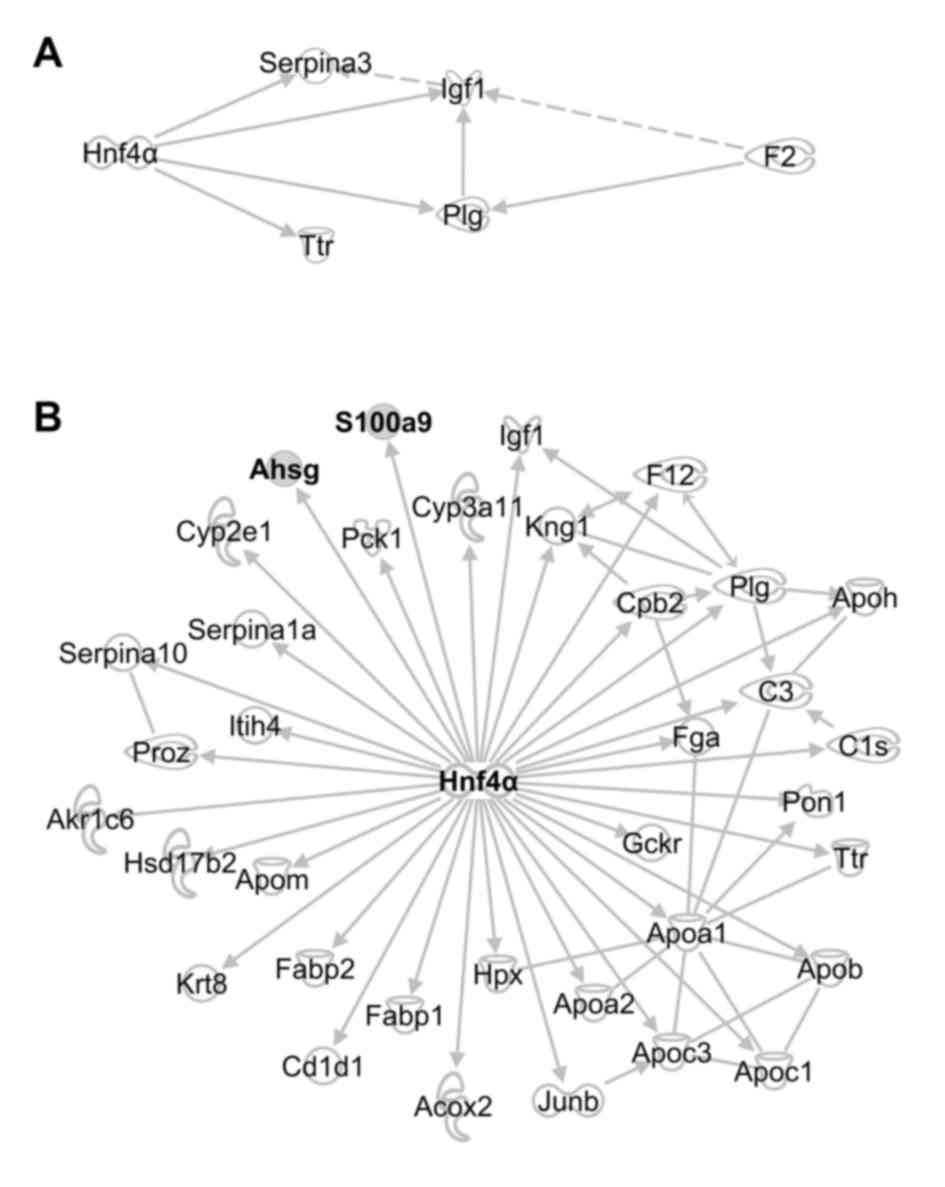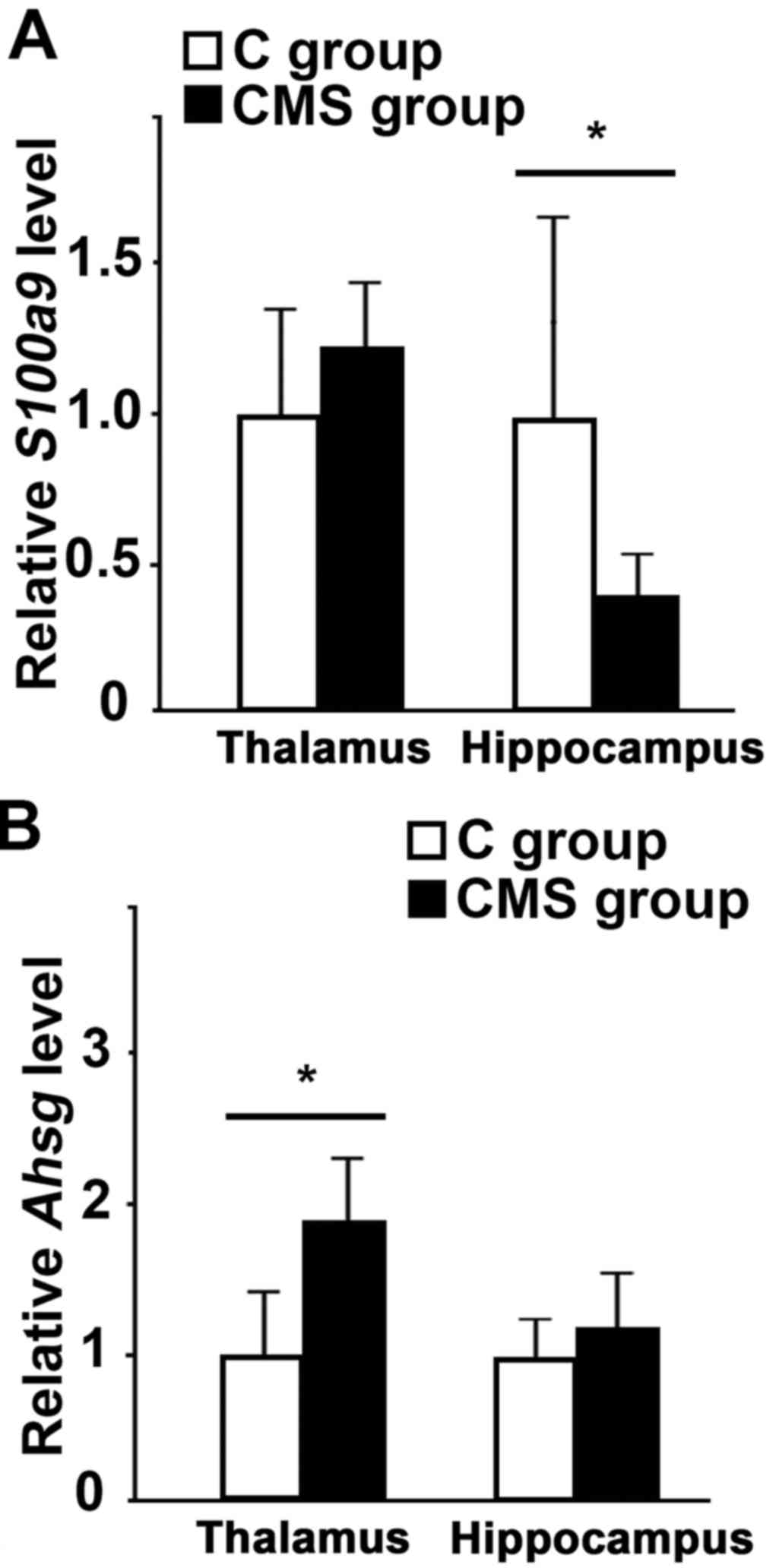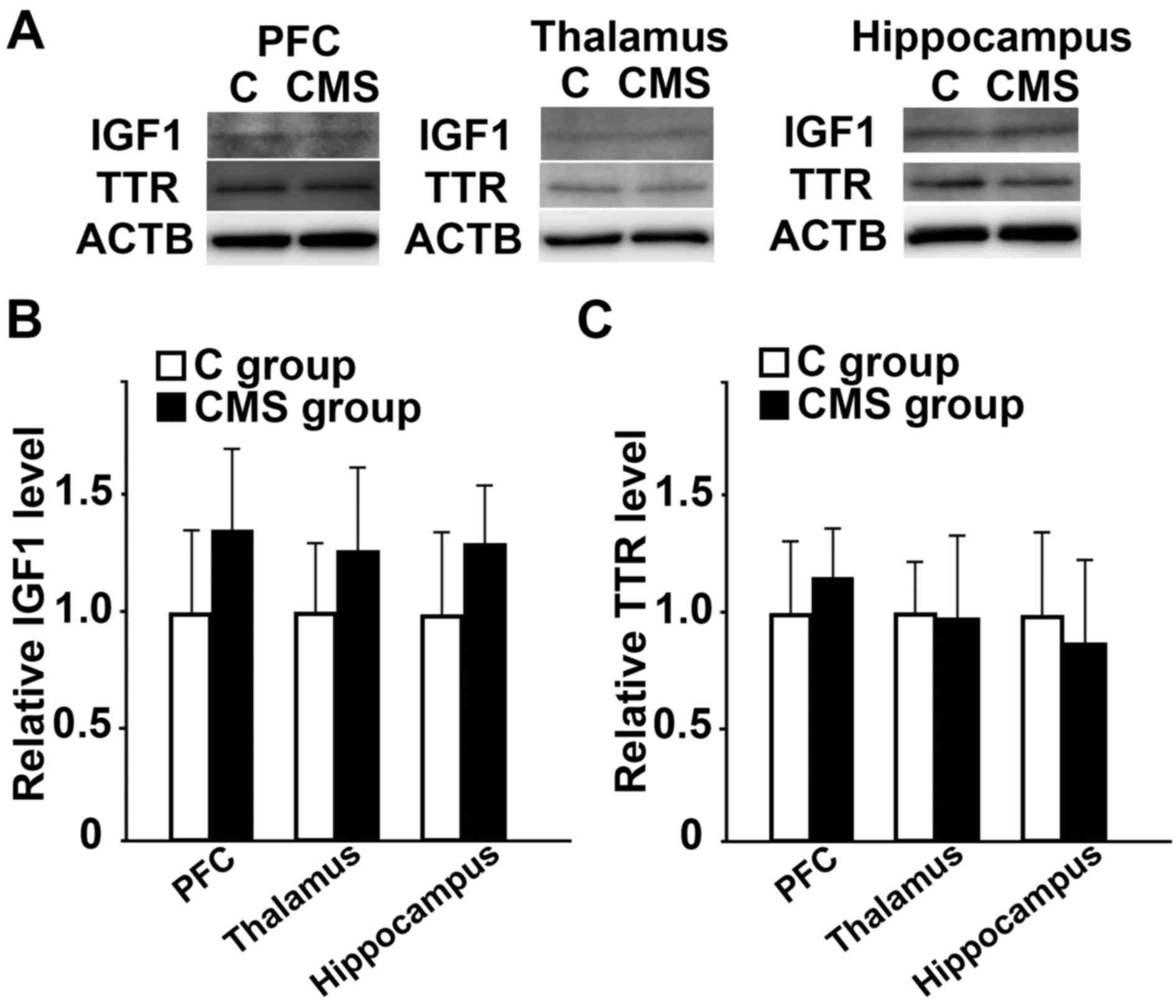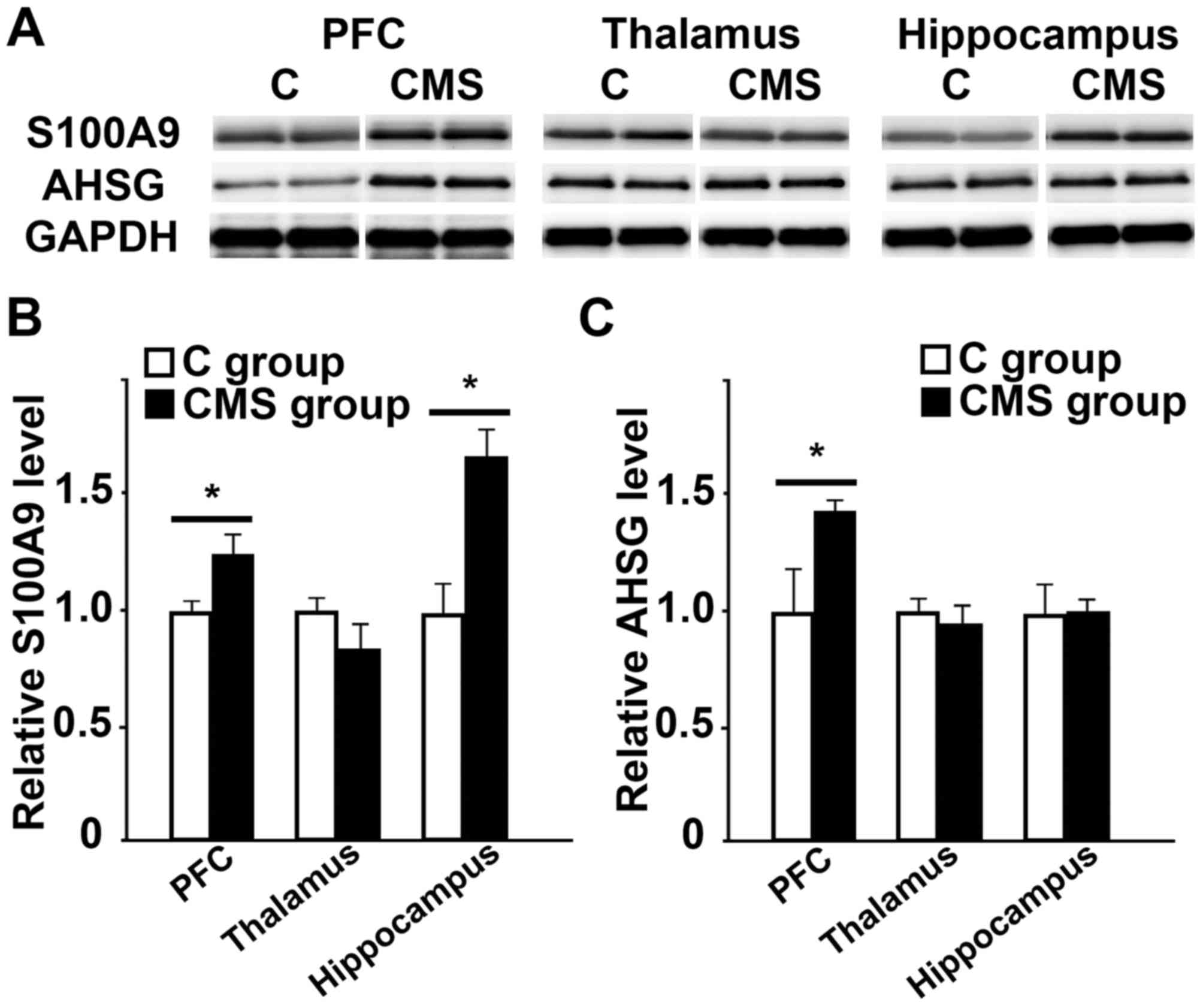|
1
|
Health Statistics Office, Vital, Health
and Social Statistics Division, . Patient Survey. Japan: Ministry
of Health, Labour and Welfare; 2011, http://www.mhlw.go.jp/english/database/db-hss/ps.html
|
|
2
|
Ministry of Health, Labour and Welfare.
Health, Labour and Welfare Report, . Ministry of Health, Labour and
Welfare. Japan: 2010, http://www.mhlw.go.jp/english/wp/wp-hw5/index.html
|
|
3
|
Slattery DA, Hudson AL and Nutt DJ:
Invited review: The evolution of antidepressant mechanisms. Fundam
Clin Pharmacol. 18:1–21. 2004. View Article : Google Scholar : PubMed/NCBI
|
|
4
|
Young EA and Korszun A: The
hypothalamic-pituitary-gonadal axis in mood disorders. Endocrinol
Metab Clin North Am. 31:63–78. 2002. View Article : Google Scholar : PubMed/NCBI
|
|
5
|
Paizanis E, Hamon M and Lanfumey L:
Hippocampal neurogenesis, depressive disorders, and antidepressant
therapy. Neural Plast. 2007:737542007. View Article : Google Scholar : PubMed/NCBI
|
|
6
|
Diener C, Kuehner C, Brusniak W, Ubl B,
Wessa M and Flor H: A meta-analysis of neurofunctional imaging
studies of emotion and cognition in major depression. Neuroimage.
61:677–685. 2012. View Article : Google Scholar : PubMed/NCBI
|
|
7
|
Sawyer K, Corsentino E, Sachs-Ericsson N
and Steffens DC: Depression, hippocampal volume changes, and
cognitive decline in a clinical sample of older depressed
outpatients and non-depressed controls. Aging Ment Health.
16:753–762. 2012. View Article : Google Scholar : PubMed/NCBI
|
|
8
|
Schiepers OJ, Wichers MC and Maes M:
Cytokines and major depression. Prog Neuropsychopharmacol Biol
Psychiatry. 29:201–217. 2005. View Article : Google Scholar : PubMed/NCBI
|
|
9
|
Slavich GM and Irwin MR: From stress to
inflammation and major depressive disorder: A social signal
transduction theory of depression. Psychol Bull. 140:774–815. 2014.
View Article : Google Scholar : PubMed/NCBI
|
|
10
|
Oxenkrug GF: Tryptophan kynurenine
metabolism as a common mediator of genetic and environmental
impacts in major depressive disorder: The serotonin hypothesis
revisited 40 years later. Isr J Psychiatry Relat Sci. 47:56–63.
2010.PubMed/NCBI
|
|
11
|
Hage MP and Azar ST: The link between
thyroid function and depression. J Thyroid Res. 2012:5906482012.
View Article : Google Scholar : PubMed/NCBI
|
|
12
|
Ross DA and Cetas JS: Steroid psychosis: A
review for neurosurgeons. J Neurooncol. 109:439–447. 2012.
View Article : Google Scholar : PubMed/NCBI
|
|
13
|
Dowlati Y, Herrmann N, Swardfager W, Liu
H, Sham L, Reim EK and Lanctôt KL: A meta-analysis of cytokines in
major depression. Biol Psychiatry. 67:446–457. 2010. View Article : Google Scholar : PubMed/NCBI
|
|
14
|
Karege F, Perret G, Bondolfi G, Schwald M,
Bertschy G and Aubry JM: Decreased serum brain-derived neurotrophic
factor levels in major depressed patients. Psychiatry Res.
109:143–148. 2002. View Article : Google Scholar : PubMed/NCBI
|
|
15
|
Shimizu E, Hashimoto K, Okamura N, Koike
K, Komatsu N, Kumakiri C, Nakazato M, Watanabe H, Shinoda N, Okada
S and Iyo M: Alterations of serum levels of brain-derived
neurotrophic factor (BDNF) in depressed patients with or without
antidepressants. Biol Psychiatry. 54:70–75. 2003. View Article : Google Scholar : PubMed/NCBI
|
|
16
|
Pedersen BK: Special feature for the
Olympics: Effects of exercise on the immune system: Exercise and
cytokines. Immunol Cell Biol. 78:532–535. 2000. View Article : Google Scholar : PubMed/NCBI
|
|
17
|
Chung S, Son GH and Kim K: Circadian
rhythm of adrenal glucocorticoid: Its regulation and clinical
implications. Biochim Biophys Acta. 1812:581–591. 2011. View Article : Google Scholar : PubMed/NCBI
|
|
18
|
Yamanishi K, Doe N, Sumida M, Watanabe Y,
Yoshida M, Yamamoto H, Xu Y, Li W, Yamanishi H, Okamura H and
Matsunaga H: Hepatocyte nuclear factor 4 alpha is a key factor
related to depression and physiological homeostasis in the mouse
brain. PLoS One. 10:e01190212015. View Article : Google Scholar : PubMed/NCBI
|
|
19
|
Yamanishi K, Maeda S, Kuwahara-Otani S,
Watanabe Y, Yoshida M, Ikubo K, Okuzaki D, El-Darawish Y, Li W,
Nakasho K, et al: Interleukin-18-deficient mice develop
dyslipidemia resulting in nonalcoholic fatty liver disease and
steatohepatitis. Transl Res. 173:101–114.e7. 2016. View Article : Google Scholar : PubMed/NCBI
|
|
20
|
Stein TD, Anders NJ, DeCarli C, Chan SL,
Mattson MP and Johnson JA: Neutralization of transthyretin reverses
the neuroprotective effects of secreted amyloid precursor protein
(APP) in APPSW mice resulting in tau phosphorylation and loss of
hippocampal neurons: Support for the amyloid hypothesis. J
Neurosci. 24:7707–7717. 2004. View Article : Google Scholar : PubMed/NCBI
|
|
21
|
Yadav A, Kalita A, Dhillon S and Banerjee
K: JAK/STAT3 pathway is involved in survival of neurons in response
to insulin-like growth factor and negatively regulated by
suppressor of cytokine signaling-3. J Biol Chem. 280:31830–31840.
2005. View Article : Google Scholar : PubMed/NCBI
|
|
22
|
Zheng WH, Kar S and Quirion R:
Insulin-like growth factor-1-induced phosphorylation of
transcription factor FKHRL1 is mediated by phosphatidylinositol
3-kinase/Akt kinase and role of this pathway in insulin-like growth
factor-1-induced survival of cultured hippocampal neurons. Mol
Pharmacol. 62:225–233. 2002. View Article : Google Scholar : PubMed/NCBI
|
|
23
|
Padmanabhan J, Levy M, Dickson DW and
Potter H: Alpha1-antichymotrypsin, an inflammatory protein
overexpressed in Alzheimer's disease brain, induces tau
phosphorylation in neurons. Brain. 129:3020–3034. 2006. View Article : Google Scholar : PubMed/NCBI
|
|
24
|
Tsirka SE, Rogove AD, Bugge TH, Degen JL
and Strickland S: An extracellular proteolytic cascade promotes
neuronal degeneration in the mouse hippocampus. J Neurosci.
17:543–552. 1997.PubMed/NCBI
|
|
25
|
Donovan FM, Pike CJ, Cotman CW and
Cunningham DD: Thrombin induces apoptosis in cultured neurons and
astrocytes via a pathway requiring tyrosine kinase and RhoA
activities. J Neurosci. 17:5316–5326. 1997.PubMed/NCBI
|
|
26
|
Geiser F, Conrad R, Imbierowicz K, Meier
C, Liedtke R, Klingmüller D, Oldenburg J and Harbrecht U:
Coagulation activation and fibrinolysis impairment are reduced in
patients with anxiety and depression when medicated with
serotonergic antidepressants. Psychiatry Clin Neurosci. 65:518–525.
2011. View Article : Google Scholar : PubMed/NCBI
|
|
27
|
Schroeder V, Borner U, Gutknecht S, Schmid
JP, Saner H and Kohler HP: Relation of depression to various
markers of coagulation and fibrinolysis in patients with and
without coronary artery disease. Eur J Cardiovasc Prev Rehabil.
14:782–787. 2007. View Article : Google Scholar : PubMed/NCBI
|
|
28
|
Kang HJ, Voleti B, Hajszan T, Rajkowska G,
Stockmeier CA, Licznerski P, Lepack A, Majik MS, Jeong LS, Banasr
M, et al: Decreased expression of synapse-related genes and loss of
synapses in major depressive disorder. Nat Med. 18:1413–1417. 2012.
View Article : Google Scholar : PubMed/NCBI
|
|
29
|
Frye MA, Nassan M, Jenkins GD, Kung S,
Veldic M, Palmer BA, Feeder SE, Tye SJ, Choi DS and Biernacka JM:
Feasibility of investigating differential proteomic expression in
depression: Implications for biomarker development in mood
disorders. Transl Psychiatry. 5:e6892015. View Article : Google Scholar : PubMed/NCBI
|
|
30
|
Lisowski P, Wieczorek M, Goscik J,
Juszczak GR, Stankiewicz AM, Zwierzchowski L and Swiergiel AH:
Effects of chronic stress on prefrontal cortex transcriptome in
mice displaying different genetic backgrounds. J Mol Neurosci.
50:33–57. 2013. View Article : Google Scholar : PubMed/NCBI
|
|
31
|
Kang X, Song Z, McClain CJ, Kang YJ and
Zhou Z: Zinc supplementation enhances hepatic regeneration by
preserving hepatocyte nuclear factor-4alpha in mice subjected to
long-term ethanol administration. Am J Pathol. 172:916–925. 2008.
View Article : Google Scholar : PubMed/NCBI
|
|
32
|
Odom DT, Zizlsperger N, Gordon DB, Bell
GW, Rinaldi NJ, Murray HL, Volkert TL, Schreiber J, Rolfe PA,
Gifford DK, et al: Control of pancreas and liver gene expression by
HNF transcription factors. Science. 303:1378–1381. 2004. View Article : Google Scholar : PubMed/NCBI
|
|
33
|
Naiki T, Nagaki M, Shidoji Y, Kojima H,
Imose M, Kato T, Ohishi N, Yagi K and Moriwaki H: Analysis of gene
expression profile induced by hepatocyte nuclear factor 4alpha in
hepatoma cells using an oligonucleotide microarray. J Biol Chem.
277:14011–14019. 2002. View Article : Google Scholar : PubMed/NCBI
|
|
34
|
Späth GF and Weiss MC: Hepatocyte nuclear
factor 4 expression overcomes repression of the hepatic phenotype
in dedifferentiated hepatoma cells. Mol Cell Biol. 17:1913–1922.
1997. View Article : Google Scholar : PubMed/NCBI
|
|
35
|
Costa RH, Van Dyke TA, Yan C, Kuo F and
Darnell JE Jr: Similarities in transthyretin gene expression and
differences in transcription factors: Liver and yolk sac compared
to choroid plexus. Proc Natl Acad Sci USA. 87:6589–6593. 1990.
View Article : Google Scholar : PubMed/NCBI
|
|
36
|
Stankiewicz AM, Goscik J, Majewska A,
Swiergiel AH and Juszczak GR: The effect of acute and chronic
social stress on the hippocampal transcriptome in mice. PLoS One.
10:e01421952015. View Article : Google Scholar : PubMed/NCBI
|
|
37
|
Wohleb ES, Powell ND, Godbout JP and
Sheridan JF: Stress-induced recruitment of bone marrow-derived
monocytes to the brain promotes anxiety-like behavior. J Neurosci.
33:13820–13833. 2013. View Article : Google Scholar : PubMed/NCBI
|
|
38
|
Li C, Li S, Jia C, Yang L, Song Z and Wang
Y: Low concentration of S100A8/9 promotes angiogenesis-related
activity of vascular endothelial cells: Bridges among inflammation,
angiogenesis, and tumorigenesis? Mediators Inflamm.
2012:2485742012. View Article : Google Scholar : PubMed/NCBI
|
|
39
|
Croce K, Gao H, Wang Y, Mooroka T, Sakuma
M, Shi C, Sukhova GK, Packard RR, Hogg N, Libby P and Simon DI:
Myeloid-related protein-8/14 is critical for the biological
response to vascular injury. Circulation. 120:427–436. 2009.
View Article : Google Scholar : PubMed/NCBI
|
|
40
|
de Seny D, Fillet M, Ribbens C, Marée R,
Meuwis MA, Lutteri L, Chapelle JP, Wehenkel L, Louis E, Merville MP
and Malaise M: Monomeric calgranulins measured by SELDI-TOF mass
spectrometry and calprotectin measured by ELISA as biomarkers in
arthritis. Clin Chem. 54:1066–1075. 2008. View Article : Google Scholar : PubMed/NCBI
|
|
41
|
Sinz A, Bantscheff M, Mikkat S, Ringel B,
Drynda S, Kekow J, Thiesen HJ and Glocker MO: Mass spectrometric
proteome analyses of synovial fluids and plasmas from patients
suffering from rheumatoid arthritis and comparison to reactive
arthritis or osteoarthritis. Electrophoresis. 23:3445–3456. 2002.
View Article : Google Scholar : PubMed/NCBI
|
|
42
|
Trendelenburg G: Molecular regulation of
cell fate in cerebral ischemia: Role of the inflammasome and
connected pathways. J Cereb Blood Flow Metab. 34:1857–1867. 2014.
View Article : Google Scholar : PubMed/NCBI
|
|
43
|
Nagareddy PR, Murphy AJ, Stirzaker RA, Hu
Y, Yu S, Miller RG, Ramkhelawon B, Distel E, Westerterp M, Huang
LS, et al: Hyperglycemia promotes myelopoiesis and impairs the
resolution of atherosclerosis. Cell Metab. 17:695–708. 2013.
View Article : Google Scholar : PubMed/NCBI
|
|
44
|
Lein ES, Hawrylycz MJ, Ao N, Ayres M,
Bensinger A, Bernard A, Boe AF, Boguski MS, Brockway KS, Byrnes EJ,
et al: Genome-wide atlas of gene expression in the adult mouse
brain. Nature. 445:168–176. 2007. View Article : Google Scholar : PubMed/NCBI
|
|
45
|
Laughlin GA, McEvoy LK, Barrett-Connor E,
Daniels LB and Ix JH: Fetuin-A, a new vascular biomarker of
cognitive decline in older adults. Clin Endocrinol (Oxf).
81:134–140. 2014. View Article : Google Scholar : PubMed/NCBI
|
|
46
|
Biswas S, Sharma S, Saroha A, Bhakuni DS,
Malhotra R, Zahur M, Oellerich M, Das HR and Asif AR:
Identification of novel autoantigen in the synovial fluid of
rheumatoid arthritis patients using an immunoproteomics approach.
PLoS One. 8:e562462013. View Article : Google Scholar : PubMed/NCBI
|
|
47
|
Mathews ST, Singh GP, Ranalletta M,
Cintron VJ, Qiang X, Goustin AS, Jen KL, Charron MJ, Jahnen-Dechent
W and Grunberger G: Improved insulin sensitivity and resistance to
weight gain in mice null for the Ahsg gene. Diabetes. 51:2450–2458.
2002. View Article : Google Scholar : PubMed/NCBI
|
|
48
|
You Z, Luo C, Zhang W, Chen Y, He J, Zhao
Q, Zuo R and Wu Y: Pro- and anti-inflammatory cytokines expression
in rat's brain and spleen exposed to chronic mild stress:
Involvement in depression. Behav Brain Res. 225:135–141. 2011.
View Article : Google Scholar : PubMed/NCBI
|
|
49
|
Lee SY, Jung YO, Kim DJ, Kang CM, Moon YM,
Heo YJ, Oh HJ, Park SJ, Yang SH, Kwok SK, et al: IL-12p40 homodimer
ameliorates experimental autoimmune arthritis. J Immunol.
195:3001–3010. 2015. View Article : Google Scholar : PubMed/NCBI
|
|
50
|
Nakajima K, Kanda T, Takaishi M, Shiga T,
Miyoshi K, Nakajima H, Kamijima R, Tarutani M, Benson JM, Elloso
MM, et al: Distinct roles of IL-23 and IL-17 in the development of
psoriasis-like lesions in a mouse model. J Immunol. 186:4481–4489.
2011. View Article : Google Scholar : PubMed/NCBI
|
|
51
|
Sunahori K, Yamamura M, Yamana J, Takasugi
K, Kawashima M, Yamamoto H, Chazin WJ, Nakatani Y, Yui S and Makino
H: The S100A8/A9 heterodimer amplifies proinflammatory cytokine
production by macrophages via activation of nuclear factor kappa B
and p38 mitogen-activated protein kinase in rheumatoid arthritis.
Arthritis Res Ther. 8:R692006. View
Article : Google Scholar : PubMed/NCBI
|
|
52
|
Xu Y, Xu M, Bi Y, Song A, Huang Y, Liu Y,
Wu Y, Chen Y, Wang W, Li X and Ning G: Serum fetuin-A is correlated
with metabolic syndrome in middle-aged and elderly Chinese.
Atherosclerosis. 216:180–186. 2011. View Article : Google Scholar : PubMed/NCBI
|
|
53
|
Ishibashi A, Ikeda Y, Ohguro T, Kumon Y,
Yamanaka S, Takata H, Inoue M, Suehiro T and Terada Y: Serum
fetuin-A is an independent marker of insulin resistance in Japanese
men. J Atheroscler Thromb. 17:925–933. 2010. View Article : Google Scholar : PubMed/NCBI
|


















